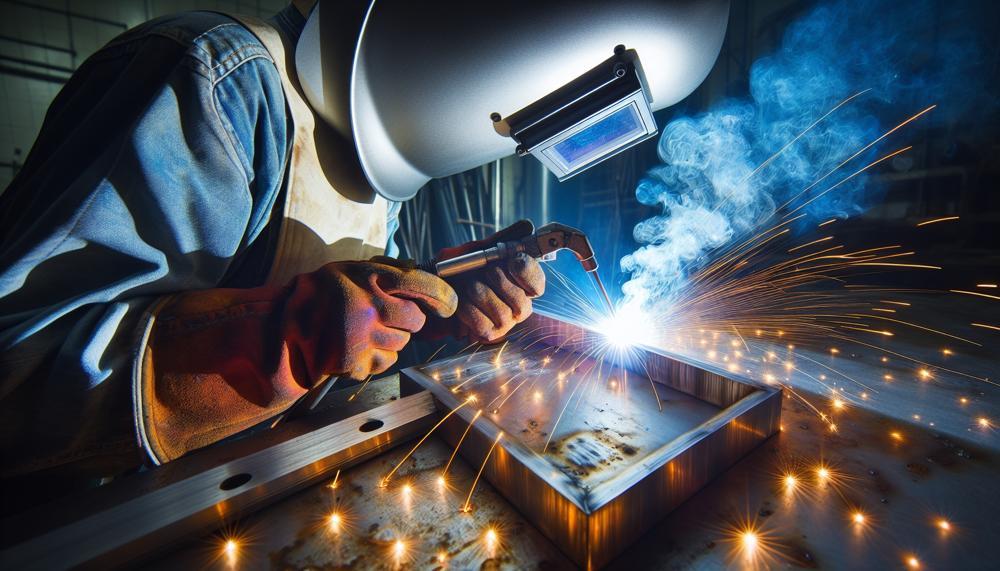Are you a welding enthusiast looking to expand your skills and knowledge? Or maybe you’re an engineer or designer. You seek new ways to join different metals for your projects. Either way, you’ve probably heard about the daunting task of welding titanium to steel.
At first glance, these two metals may seem like an unlikely pair. This is due to their stark differences in properties and composition. But don’t let that discourage you. There is actually a possibility of successfully welding them together.
However, before we dive into the details, let’s take a quick look at some key points:
- Titanium and steel have vastly different melting points, making it challenging to fuse them together.
- The high reactivity of titanium makes it susceptible to contamination during the welding process.
- Despite these challenges, with proper techniques and equipment, it is possible to achieve a strong bond between these two metals.
- Welding titanium to steel can open up opportunities for creating lightweight and durable structures in various industries such as aerospace and automotive.
In this blog post, we’ll delve into the complexities of welding titanium to steel and explore potential solutions. So put on your safety gear and get ready to learn something new.
Contents
Can You Weld Titanium to Steel?
Yes, you can weld titanium to steel. However, it is a challenging and complex process. It requires specialized equipment and skilled welders.
The two metals have vastly different properties, which makes welding them together difficult. Titanium is lightweight, strong, and corrosion-resistant. Steel is heavier, less strong, and more corrosion-prone. The two metals have different melting points. This makes welding them together challenging.
Choose the Right Filler Material
When it comes to welding titanium to steel, choosing the right filler material is crucial. Key factors to consider include the compatibility of metals, strength, and ductility. Also, consider corrosion resistance, welding process, and cost.
These factors significantly affect the weld joint’s effectiveness and durability. They determine the joint between titanium and steel.
Compatibility of Metals:
- Titanium and steel have unique properties that can impact the welding process.
- It is essential to choose a filler material that is compatible with both metals to create a strong joint.
- Commonly used filler materials include nickel-based alloys, copper-based alloys, and titanium-based alloys.
Strength and Ductility:
- The filler material must be able to withstand high temperatures and stresses during welding.
- It should also maintain its strength and ductility after being welded to titanium and steel.
- For structural applications, it is crucial to select a filler material with a high strength-to-weight ratio.
Corrosion Resistance:
- Both titanium and steel are prone to corrosion.
- It is vital to use a filler material that can resist corrosion from both metals.
- Titanium-based filler materials are highly resistant to corrosion.
Welding Process:
- Different welding processes require different types of filler materials.
- For TIG welding, wire or rod filler materials are commonly used.
- For MMA welding, a coated electrode is the preferred option.
Cost:
- Consider the overall cost, including shipping and handling fees.
- While titanium-based filler materials may be more expensive, they offer excellent compatibility and corrosion resistance.
Prepare Your Base Metals
Properly preparing base metals for welding titanium to steel is crucial for creating a strong, durable, and cost-effective weld joint. To achieve this, follow these steps:
- Clean the Base Metal: Before welding, it is vital to thoroughly clean the base metal. This step removes any contaminants that can negatively impact the welding process. To ensure a clean surface, use a cleaning agent specifically made for titanium.
- Avoid Chlorine-Containing Materials: When cleaning the base metal, be sure to avoid using any chlorine-containing materials. These substances can cause contamination and affect the welding process.
- Choose the Right Shielding Gas: The appropriate shielding gas is essential for protecting the weld from atmospheric elements. Helium or pure argon are commonly used for welding titanium as they provide excellent protection and stability.
- Select the Correct Filler Wire: Choosing the correct filler wire is crucial for achieving a strong and ductile weld joint. It is important to select a filler wire with similar properties to the base metal for optimal compatibility and strength.
- Use the Appropriate Welding Process: There are several welding processes that can be used for welding titanium to steel, such as GTAW, FRW, EBW, PAW, GMAW/MIG, LBW, and RW. Each process has its own advantages and limitations, so it’s essential to choose the one that best suits your needs and experience.
- Utilize a Low Amperage Welder: When welding titanium, it is crucial to use a low amperage welder to prevent overheating and distortion of the base metal.
- Maintain a Protective Argon Flow: After welding, it’s vital to maintain a protective argon flow until the weld cools down below 500F. This ensures that no atmospheric elements contaminate the weld.
- Inspect the Weld Color: The color of the weld can indicate its quality. A silver, straw, or brown color is acceptable, while a green, blue, gray, or white color indicates failure. If the weld has discolored during the process, it may be necessary to start over.

By following these steps and properly preparing your base metals, you can ensure a successful and cost-effective weld joint when working with titanium and steel. Always prioritize safety and use appropriate protective gear when welding.
Heat Up Your Metal
The heating process is crucial in welding titanium and steel. It prepares the base metals for welding and ensures a strong, durable joint. However, the effects of heating up metal can vary between these two metals.
For titanium, excessive heating can cause it to become brittle and difficult to weld due to its low melting point. Precise temperature control is necessary during welding. This is to avoid warping or distortion of the metal. This can hinder achieving a clean and precise weld.
In contrast, steel requires significant heat to be properly welded due to its higher melting point compared to titanium. If the temperature is too low, a weak and incomplete weld may result.
The temperature at which the metal is heated also affects the strength and integrity of the weld. A high temperature can create a strong fusion between the base metals. A low temperature may result in a weak weld.
Proper cooling techniques are also crucial when heating up metal for welding. Slow cooling methods must be used after welding to prevent cracks or distortions from forming. Rapid cooling methods, like quenching, should be avoided as they can weaken the weld.
Different welding methods require varying levels of heat for titanium and steel. For instance, TIG welding requires precise heat control and argon flow for both metals. MIG welding involves higher temperatures for steel compared to titanium.
Apply Filler Material
When joining titanium and steel through welding, it is vital to carefully select a filler material with a lower melting point than titanium. The filler material should have comparable characteristics to both metals.
For this type of welding, nickel-based and copper-based alloys are often used as filler materials. Each type offers distinct benefits based on the project’s specific requirements.
Methods for Welding Titanium to Steel
There are several methods for welding titanium to steel, including:
- Solid-state welding: This method does not involve melting the metals. Instead, the two metals are joined together by applying pressure and heat.
- Fusion welding: This method involves melting the metals at the weld joint.
- Brazing: This method involves using a filler metal to join the two metals together.
Conclusion
In conclusion, the task of welding titanium to steel may seem daunting at first. This is because of their contrasting properties and composition.
However, with proper techniques and equipment, a strong bond between these two metals can be achieved. Selecting the right filler material and preparing the base metals thoroughly are crucial for creating a successful weld joint. Controlling temperature and heat precisely, and utilizing suitable welding processes are also important.
This opens up new possibilities for lightweight and durable structures in industries such as aerospace and automotive.
As a welding engineer, expanding your skills and knowledge in this area can greatly benefit your projects.
So, don’t let the challenges discourage you. Gear up with safety equipment and get ready to embark on a journey of learning something new.





